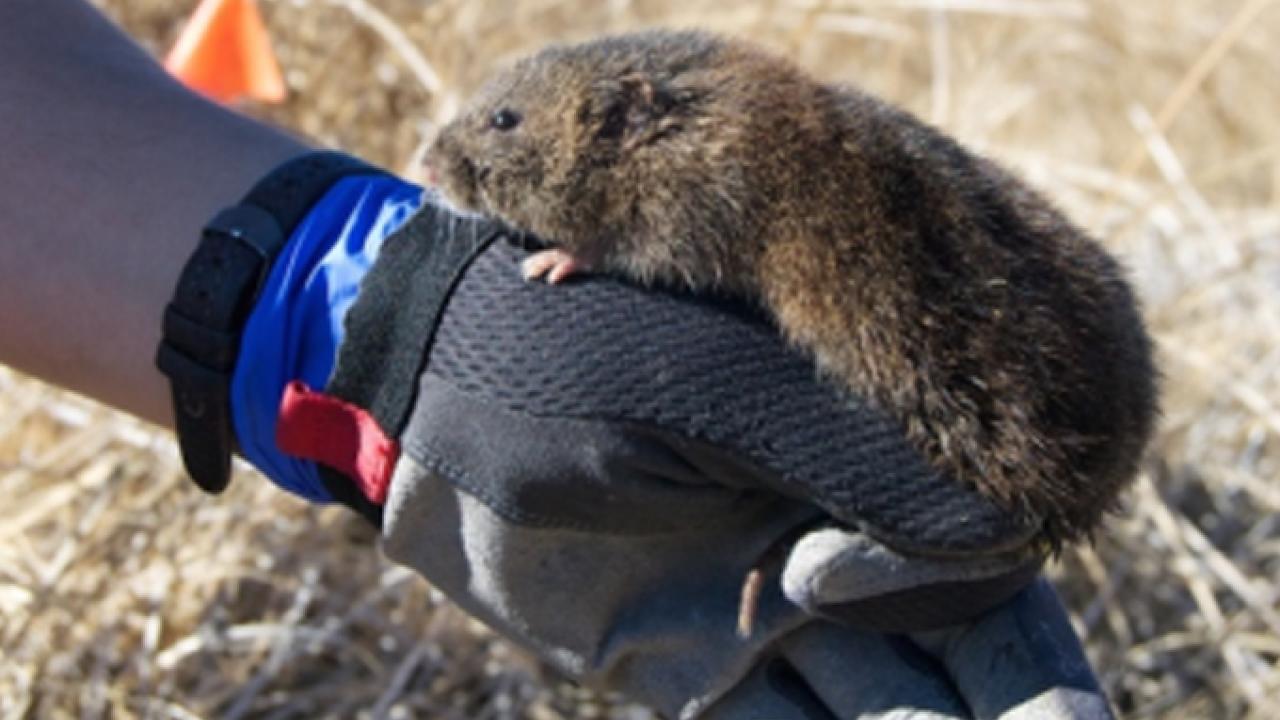
Endangered Voles
Habitat conservation urgently needed
Despite the welcome rains in California this year, the fate of endangered Amargosa voles that depend on rare marshes in the Mojave Desert remains dire, with only about 500 animals remaining in the wild and most of their habitat degraded or dying.
Comprehensive planning to mitigate human-caused climate change, secure water, restore and enhance marshes, and manage vole genetic and disease stressors are urgently needed to reduce the species’ high extinction risk. That is according to a report detailing a wide-range assessment commissioned by the California Department of Fish and Wildlife and implemented jointly by biologists with the department, UC Davis and the U.S. Geological Survey.
Over the past five years, the team has conducted intensive research and initiated last-ditch intervention attempts to save the species — including a captive breeding program at the UC Davis School of Veterinary Medicine. But these efforts may not be enough.
Increased risk of extinction
The researchers found that as of 2016, water to support this highly specialized rodent is becoming increasingly variable. As a result, risk of extinction for this species — entirely dependent on marshes near Tecopa Hot Springs, Inyo County — has increased over the last decade.
“Retrospective satellite data provide pictures of vegetation over time, giving us the best proof to date of the effect of climate change over several decades,” said project lead Janet Foley, a professor of medicine and epidemiology at the School of Veterinary Medicine. “Even occasional rainy seasons won’t combat the water insecurity we are witnessing in this driest part of the Mojave Desert.”
Key findings from the report
- The network of springs and marshes in the vole’s natural range has been so extensively modified by humans that the vole’s future existence will depend almost entirely on whether humans continue to supply water where and when needed. The report advises agency leaders to engage more with landowners to monitor and manage water use, acquire water rights, obtain direct control of water currently leased by Inyo County, and work with federal and state lawmakers to find solutions to global climate change.
- Of more than 80 previously identified and cataloged marshes, about 20 remain, most of which are degraded, dying and too small to sustainably support subpopulations of voles.
- Satellite imagery of vegetation, and plant and water data show that global climate change, compounded by the drought, has reduced water regionally over the past few decades. Worse, inconsistent water availability increases the likelihood of catastrophic drying and extinction for the voles.
- Vole numbers fluctuated over the past five years. Although all larger marsh patches showed some evidence of vole activity in 2016, only 500 voles or fewer remain in the population, and 80 percent of the animals are adult. Of the smaller patches, only 38 percent show evidence of vole activity. Low rates of survival continue to limit recovery of the species.
- Total available habitat (bulrush cover) decreased 37 percent between 2012 and 2015 although an intensive restoration effort at what was once the largest patch shows good progress and is likely to produce a single sustainable patch for the vole.
- The most strongly significant predictor for vole numbers per marsh was average water depth, via its influence on bulrush health, while proximity to a nearby marsh was a marginal predictor. Voles are almost always recaptured near where they were originally caught, but the scientists documented 11 occasions of voles moving between marshes, as much as nearly an acre per day. This suggests the voles may be wandering farther in search of resources to survive.
- Modifying vole habitat could create additional sustainable patches with little expected risk of subpopulation extinction. Techniques could include reconfiguring water inflow, outflow, marsh size, elevation contour and vegetation to enhance extant marshes or better connect adjacent marshes.
“This conservation effort to save the vole and its fragile ecosystem represents the tireless work of a diverse group of dedicated professionals and community members,” said project co-lead Deana Clifford, senior wildlife veterinarian with the state Department of Fish and Wildlife. “Only by continuing to work together will we find proactive climate and water solutions that can support the marshes and voles, as well as the desert communities of the Amargosa.”
The report was funded by the state’s Drought Response Implementation Program and the state Office of Emergency Services.
Media contact(s)
Janet Foley, UC Davis School of Veterinary Medicine, 530-754-9740, jefoley@ucdavis.edu, cell: 530-304-6493
Deana Clifford, California Department of Fish and Wildlife, 916-358-2378, Deana.Clifford@wildlife.ca.gov
Trina Wood, UC Davis School of Veterinary Medicine, 530-752-5257, tjwood@ucdavis.edu